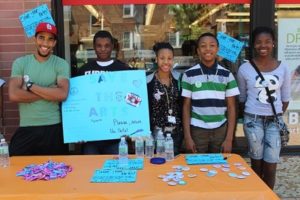Lessons in Going to Scale is a newly-launched blog series featuring on-the-ground stories from nonprofit organizations at different points in their scaling trajectory. Hear from S&I 100 CEOs and nonprofit leaders in health, education, youth, and poverty alleviation about the strategies and challenges of developing a scaling model.

S&I 100 organization Wyman Center explores what it looks like to adapt their Teen Outreach Program® model to settings outside of their network.
At Wyman Center, we take scaling with fidelity very seriously. The organization has a 115 year history serving children from low-resource environments, and the past 15 years have focused on nationally replicating programs, such as our evidence-based Teen Outreach Program®(TOP). TOP® is a nine-month program for teens in 6th to 12th grade that reduces the risk of problem behavior while helping teens make healthy choices, develop life skills and engage with their communities.
In order to meet our growth goal to bring faithfully-replicated TOP® into the lives of 100,000 teens in the next five years, we developed a rigorous quality system and infrastructure to both support and monitor our 57 Certified Replication Partners.
Wyman directly delivers TOP® within the St. Louis area, but outside of St. Louis, we certify other youth-serving organizations to deliver the program. We officially created Wyman’s National Network in 2009, a system that includes seven elements of fidelity (which can be accessed here).
About a year ago, when an Assistant Deputy Secretary from the U.S. Department of Education asked me how we reach the teens that are “disconnected” from traditional school settings, and may be in the juvenile justice system or in foster care, I was a bit stumped. Our in-school replication was impressive and calculated, but we were missing some of the most vulnerable teens by primarily focusing our scaling efforts within larger urban school systems. I immediately began to consider: Can we provide scale and impact with evidence-based programs, while accepting adaptations to our traditional delivery settings?
The conversation with the Assistant Deputy Secretary was the jumping off point for Wyman to explore how we could accommodate adaptations and program models to serve those teens that were “disconnected.” Through the end of 2011, we did not allow any adaptations, and maintained strict fidelity with each of our partners, who served 15,000 disadvantaged teens in 2012. At the time, we had only approved one adaptation to serve youth in the foster care system. But by the end of 2012, we added five more approved adaptations to serve teens in the juvenile justice system and foster care.
Having recognized the need to serve teens that are disconnected from the more traditional systems, we went about creating criteria for partners that wanted to adapt TOP® within their own community setting. Working closely with our internal team, external evaluators, and youth development practitioners, we established the criteria to proceed. With input from many experts, we decided we would accept limited adaptations with the following criteria:
- Partners must submit an application, explaining why they want to adapt TOP®, and must work with an evaluator to analyze impact for their adaptation.
- Partners must have demonstrated a track record of success and capacity to serve disconnected youth.
- Wyman controls the program variables, which can be adapted, and are currently focused on dosage and community service learning. For example, some partners want to double the dose in half the time; others want to determine if half the dose will still achieve positive youth outcomes. Regarding community service learning, we are working with partners in foster care and juvenile justice to reframe service as a positive societal contribution with important youth engagement. This is in contrast to the typical mandatory service clean-up or “chain gang” type of approach.
- Wyman has limited the number of adaptations and we expect partners to continue to give us both teen outcome data and program quality data.
- Wyman created several Community of Practice (COP) groups with our partners, including one with our partners utilizing adaptations for disconnected youth.
Although our adaptation process is relatively new, Wyman has already begun to experience significant interest from new prospective partners in juvenile justice and children’s welfare. Existing partners in adolescent health and education are also beginning to devise a plan to utilize TOP® to serve the disconnected teens in their networks. Early signs suggest that adaptation and expansion of TOP® to reach teens in more diverse settings will be a critical component, as we fulfill our vision to serve 100,000 teens in five years.
To learn more about Wyman Center and their scaling plans, visit their S&I 100 profile.
Joe Miller is the Senior VP of Wyman’s National Network leading the national replication of Wyman’s Teen Outreach Program®. He is an Annie E. Casey Fellow, and blends 17 years of executive experience in the private and nonprofit sectors.